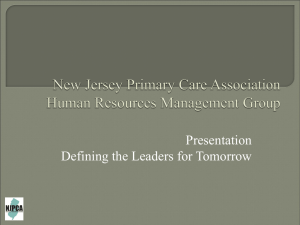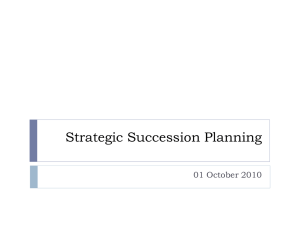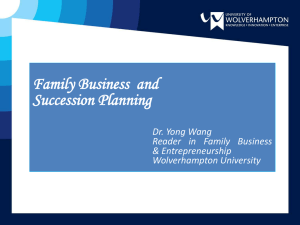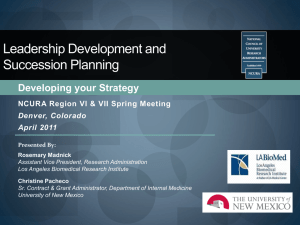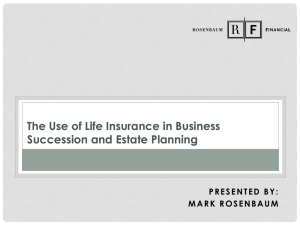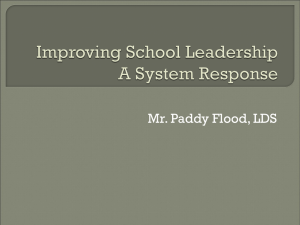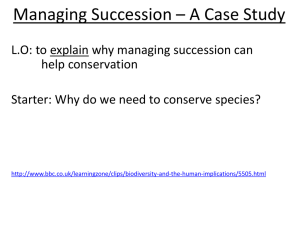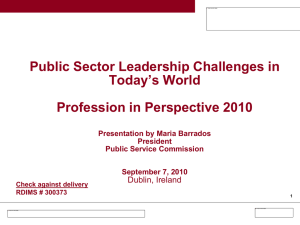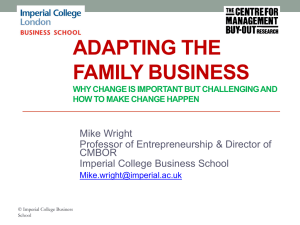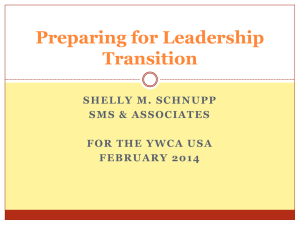Succession Planning - Massachusetts Library System
advertisement
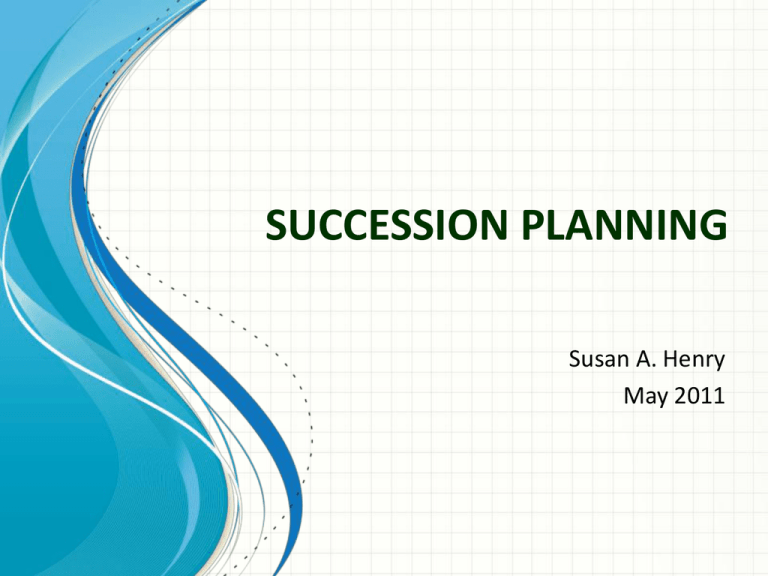
SUCCESSION PLANNING Susan A. Henry May 2011 Introductions • Who we are – Do you have a current appraisal system? – Do you have a formal succession method? • What are your expectations for the day • Naming of a Scribe for the Day Workshop Objectives • To understand your role in succession planning . • To clarify the importance of a Library Succession Planning System • To share and exchange ideas, procedures and methods you currently use. • To identify and analyze critical positions requiring backups on a temporary or permanent basis • To identify the best methods for performance appraisals and then use them in the succession planning model. • To examine methods of grooming high-potential employees for advancement by narrowing developmental gaps between present performance and future potential Succession Planning Strategy • Why You Need One - Library Economics and Employee Retention. All the “what if’s” – Life Happens. • Developing the Plan - What Tools and Programs Are Needed • How To Identify Your Successor(s) • How To Mentor/Model Your Successor(s) • Creating An Environment That Everyone Enjoys Being A Member. • When Plans Go Bad - You Thought They'd Stay Forever Succession Planning and Management • A deliberate and systematic effort by an organization to: – ensure leadership continuity in key positions – retain and develop future intellectual and knowledge capital – encourage individual advancement – Succession Planning is managed to ensure success • Should also address the needs for critical backups and individual development in any job category Definition of Succession Planning “Succession planning is a means of identifying critical management positions starting at manager and supervisor levels and extending up to the highest position in the organization.” William J. Rothwell Effective Succession Planning (2001) Succession planning should not and must not stand alone. It must be paired with succession management which creates a more dynamic environment. Succession Planning • Does your library have an established succession plan? • Replacement versus Succession Planning • Do your current employees have the skills and experience need to fill critical positions? Multiple Purpose…. • Leanness of the organization • Dwindling pool of candidates • Lack of qualified internal candidates • Increased demand and lack of incentives • Lack of a Formal Leadership Development Process The Benefits Leave a legacy behind as good employer Provide a Development Plan for Top Critical Positions Increased Leadership/Employee/Satisfaction Ability to measure leadership outcomes tied to the Strategic Library Plans for performance. Create a pool of high quality leaders to fill critical positions Break Time…. Come back prepared to present your Library….. Sharing our Organizations • Present your Library to Us. • Formal Appraisal Program – Do you Have one, do you use it. • Do you have a successor identified. • Ranking your employees • If you were gone tomorrow, who would take over? Do you have contingency plans. The “Simple” Appraisal Process • • • • • • Monthly Self-Appraisals Monthly Staff Meetings Quarterly Strategic Meetings Annual Self Appraisal Annual Performance Appraisal Creating goals for Career Development and Succession. Here’s What We Know…. 1. Leaders really do matter … in managing/driving accountability, results, culture. 2. Performance is what counts … top performers over high potentials (the “what” & “how” both count). 3. Today’s top performing leaders aren’t necessarily tomorrow’s … even our best leaders can fall behind or derail. 4. Talent is an enterprise resource … willingness to share talent makes the system work. 5. A broad set of experience & assignments is the best classroom … yet a balanced approach is still necessary for development. 6. It’s incumbent upon today’s libraries to leave a legacy of future talent … current leaders must teach, mentor, & role model others on what it takes to succeed. 7. Invest in the best … focus the rest. The Succession Model On-The-Job Expe rience s M entoring or Coaching 55-65% 25-30% Training or Continuing Education M otivated SelfDe velopme nt “We put good people in big jobs before they are ready.” —Pepsi Co. Job/Analysis Competency Development Measure Results Hiring/Selection Employee Retention Leadership Development Process Succession Planning Talent Management Strategy 360 Degree Feedback Career Development Performance Management Succession Planning: Key Elements 1. Assessment of Key Positions: • What are the competencies and experiences needed to qualify for each key position? 2. Identification of Key Talent: • Typically people at the top two levels of the organization and high potential employees one level below. • Identified by their management’s assessment of their performance and potential for advancement. 3. Assessment of Key Talent: • For each person on the radar screen, primary development needs are identified focusing on what they need in order to be ready for the next level. Succession Planning: Key Elements 4. Generation of Development Plans: • A development plan is prepared for how we will help the person develop over the next year. 5. Development Monitoring & Review • An annual or semi-annual succession planning review is held to review progress of key talent and to refresh or revise their development plan. SUCCESSION CANDIDATES KEY POSITION TITLE ________________________ Backup Candidate Name: ______________________ Current Title: ________________________________ Div: ______________ Level of Readiness (Circle One): Within 1 Yr. 1–3 Yrs. 3–5 Yrs. ____________________________________ ______________ Strengths for this position: SUCCESSION PLAN SUMMARY ORGANIZATION:_____________________ Key Position Title Incumbent Name Position Vulnerability Open in < 1 Yr Open in 1–3 Yrs Open in 3 + Yrs Succession Candidate Names Ready in < 1 Yr Ready in 1–3 Yrs Ready in 3 + Yrs EXECUTIVE DEVELOPMENT PLAN NAME: ________________ 2. Special Assignment: (What task force, projects, or special assignments will be given this year to aid development?) TITLE: ________________ Overall Performance Summary: (Indicate recent performance including major accomplishments or performance issues.) Key Strengths: (List 2 - 3. Indicate key technical or professional competencies, skills, or knowledge the person has.) Development Needs: (List 2 or 3. Indicate key experiences, skills, or knowledge the person lacks in order to move to the next level.) 3. Training: (What specific training or seminars are recommended this year for his/her development?) Potential For Promotion: (Indicate this persons readiness to be promoted to the next organizational level.) Ready now for the next level. Ready in the next 24 months. Ready in 2 to 3 years. Development Actions: 1. On The Job: (What new responsibilities do you plan to assign to help this person develop this year?) Recommended Next Position: (List the next assignment that would most benefit the individual in his/her development.) PLANS FOR SELECTED TALENT ORGANIZATION:_____________________ Name Title High Level Plan LIBRARY DIRECTOR Experiences Profile 1. Bottom line accountability; Has managed a P&L 2. Experience in several different functional assignments 3. Management of Employees 4. What kind of computer skills? 5. Educational element 6. Management of a library during a downturn; Has effected a turnaround 7. Successful public relations with community 8. Implementation of new programs and collections 9. Significant customer contact 10. Successful experience in transforming the culture of an organization COMPETENCIES • Reporting & Report Reading • Financial Reporting & Data Recording • Integrity & Trust • Cash Management • Investment • Leadership & Influence • Fund Accounting • Internal Control • • • • • • • • Management Accounting Assertiveness & Confidence Resource Planning HR Systems & Policies Regulatory Compliance Technical Competence Industry Knowledge Travel & Procurement LIBRARY DEVELOPMENT TOOLBOX On The Job: • Job Enrichment • Special Projects • Committee Assignments • Task Force Participation • Lead Person Responsibilities • Giving Presentations • Preparing Proposals/Grants • Installing A New System/Updates • Leading A New Program • Temporary Job Assignments • Full Job Change Learning From Others • Working With a Mentor • Teaming with an Expert - MLS • 360 Feedback • Focused Interviews Training & Education • Seminars & Conferences • Continuing Education • E Learning • Cross Training Highest to Lowest Return… Full Job Change Focused On Development Needs Job Restructuring Based On Development Needs Mini Library Budget Assignments Cross Library Project Shadowing or Assignment Focused Coaching & Counseling Formalized Education Programs Full 360 Degree Feedback and Evaluation Motivated Self Development Seminars and Conferences … Lowest Return Workforce Forecasting • Conduct a long and short term workforce forecasting plan to identify the workforce needs. • Conduct a study to determine the environmental changes, trends expected in 2, 5, 10 years • Create a workforce plan spanning 2, 5, 10 years out • Define the critical replacement positions, potential for recruitment internally and externally • Define career development needs for positions involved Let’s Review…. Succession Planning Process – To create a system for succession planning that meets the needs of the organization and provides career growth opportunities for individuals based on their readiness, talent, and skills. – To identify key leadership competency behaviors, skills, and knowledge needed to prepare high potentials for future key leadership roles. The Appraisal Process & Review • Conduct Annual Performance Reviews • Utilize Monthly & Quarterly Performance Reports • Report development progress and make necessary adjustments to the plan • Orchestrate moves for the next six months Five Questions to Ask? • Who’s in the leadership pipeline? • What are the most pressing developmental needs? • How are these needs being met? • What is the impact? • How are the efforts to build the leadership pipeline being evaluated? Integrated Approach to Building the Leadership Pipeline Program Evaluation Your Role In Succession Planning • As a Library Director, it’s your role to ensure: • Identify key replacement needs and the high-potential people and critical positions to include in the succession plan • Clarify present and future work activities and work results • Compare present individual performance and future individual potential • Establish individual-development plans (IDPs) to prepare replacements and to develop high-potential workers Gain Buy In On All Levels • Gain buy in from your staff. • Form committees to ensure the planning, implementation and follow-up is successful … Utilize outside organizations , such as: – – – – Board Members and Trustees Town HR Team and Individual Responsibilities Library Friends Area Businesses and Community Organizations Conclusions… • Talent management improves the skills and talents of and increases the performance of your library staff • Staff enjoy the feeling of personal growth and satisfaction that comes from the opportunity to develop their skills and better contribute to their team SO, WHAT’S NEXT?
